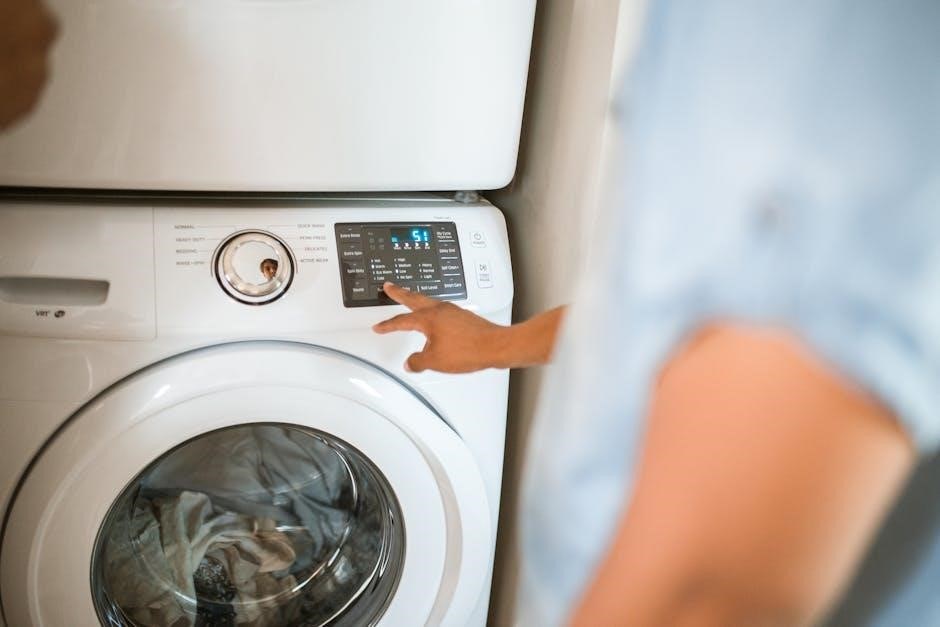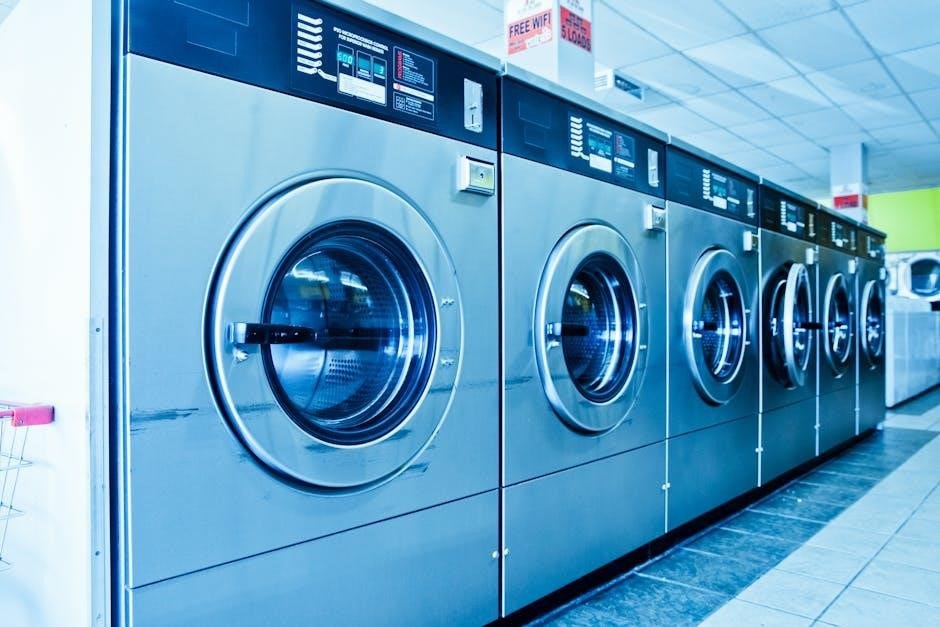The GE self-cleaning oven offers a convenient way to maintain a clean oven interior without the need for harsh chemicals or excessive scrubbing. By utilizing high heat‚ it effectively burns off food residue‚ leaving behind easily removable ash. This feature saves time and effort.

Understanding the Self-Cleaning Feature
The self-cleaning feature in GE ovens represents a significant advancement in kitchen appliance technology‚ offering a hands-free method for removing baked-on food and grease. This process relies on extreme heat‚ typically reaching around 880 degrees Fahrenheit (471 degrees Celsius)‚ to incinerate the accumulated grime within the oven cavity. Understanding how this feature works is crucial for safe and effective operation.
Unlike traditional cleaning methods that involve manual scrubbing and potentially harsh chemicals‚ the self-cleaning cycle transforms food soils into a fine ash. This ash can then be easily wiped away with a damp cloth‚ eliminating the need for strenuous effort. However‚ it’s vital to understand the nuances of the self-cleaning process.
Different GE oven models may offer variations in the self-cleaning cycle‚ including options for cycle length and intensity. It’s essential to consult the user manual specific to your oven model to fully grasp its capabilities and recommended usage. This knowledge empowers you to utilize the self-cleaning feature effectively and safely‚ maintaining a clean oven.
Key Features of GE Self-Cleaning Ovens
GE self-cleaning ovens boast high-temperature cleaning reaching 880°F‚ turning food soils into ash. Some models offer a Steam Clean option for minor spills. These features simplify oven maintenance‚ saving time and effort.
High-Temperature Cleaning
The high-temperature self-cleaning feature in GE ovens is a powerful function designed to thoroughly clean the oven’s interior. This process involves heating the oven to extremely high temperatures‚ typically around 880 degrees Fahrenheit (471 degrees Celsius). At this intense heat‚ food residues‚ grease splatters‚ and baked-on spills are effectively incinerated‚ leaving behind only a small amount of ash.
This ash can then be easily wiped away with a damp cloth after the cleaning cycle is complete and the oven has cooled down. This method eliminates the need for harsh chemical cleaners or extensive manual scrubbing‚ offering a convenient and efficient way to maintain a clean oven.
It is important to note that during the high-temperature cleaning cycle‚ the oven door will automatically lock for safety reasons. This prevents accidental opening of the oven while it is operating at such high temperatures. The door will remain locked until the cleaning cycle is finished and the oven has cooled sufficiently.
Steam Clean Option
The Steam Clean option available on some GE self-cleaning ovens offers a gentler alternative to the high-temperature cleaning cycle. This feature is ideal for light cleaning and maintenance‚ particularly for addressing minor spills or fresh splatters before they become heavily baked on. Unlike the high-temperature cycle‚ the Steam Clean option utilizes a lower temperature and relies on the power of steam to loosen food debris.
To use the Steam Clean function‚ you typically pour a cup of water into the bottom of the oven cavity. The oven then heats up‚ converting the water into steam. This steam circulates throughout the oven‚ softening and loosening any food residue. The entire process usually takes around 30 minutes‚ significantly less than the high-temperature cycle.
After the Steam Clean cycle is complete‚ you can easily wipe away the loosened residue with a damp cloth or sponge. The Steam Clean option is a convenient and time-saving way to keep your oven clean with less intense heat.
Preparing Your GE Oven for Self-Cleaning
Before initiating the self-clean cycle on your GE oven‚ ensure proper preparation by removing all oven racks‚ cookware‚ and accessories. This step is crucial for optimal cleaning and prevents damage to these items.
Removing Oven Racks and Accessories
Prior to initiating the self-cleaning cycle on your GE oven‚ a crucial step involves the removal of all oven racks and accessories. This is paramount for ensuring the effectiveness of the self-cleaning process and preventing potential damage to these components. Standard‚ shiny‚ or silver racks should be removed‚ as the high heat can cause discoloration‚ warping‚ or other damage.
Furthermore‚ any meat probes‚ baking stones‚ cookware‚ or other items present inside the oven must also be taken out. These items are not designed to withstand the intense temperatures reached during the self-clean cycle‚ which can reach approximately 880 degrees Fahrenheit (471 degrees Celsius). Leaving these items inside could result in melting‚ warping‚ or other irreversible damage.
Enamel racks (dark color) are the exception and can remain inside during the self-clean cycle. Always consult your specific GE oven model’s user manual for detailed instructions and any specific recommendations regarding rack removal for your particular appliance. Taking the time to properly prepare the oven will prevent damage and ensure the self-cleaning cycle works effectively.

Step-by-Step Instructions for Using the Self-Clean Cycle
To initiate the self-clean cycle‚ ensure the oven is empty. Close the door securely‚ and then press the “Self Clean” button on the control panel. A default cleaning time will be displayed‚ adjustable as needed.
Setting the Self-Clean Time
After selecting the self-clean function on your GE oven‚ the next crucial step involves setting the appropriate cleaning time. The duration of the self-clean cycle directly impacts the thoroughness of the cleaning process. Consider the level of residue buildup within your oven when determining the ideal time.
For ovens with light to moderate soiling‚ a shorter cleaning cycle‚ typically ranging from two to three hours‚ may suffice. This timeframe will effectively burn off most food splatters and grease without unnecessarily prolonging the process. However‚ heavily soiled ovens with significant baked-on residue may require a longer cycle‚ potentially lasting up to four or five hours.
Refer to your GE oven’s user manual for specific recommendations regarding self-clean time based on the degree of soiling. Some models may offer pre-programmed cleaning cycles with varying durations‚ simplifying the selection process.
To adjust the self-clean time‚ use the arrow buttons or number pad on your oven’s control panel. Carefully increase or decrease the time until you reach the desired duration. Once set‚ confirm your selection by pressing the “Start” button.
What to Expect During the Self-Clean Cycle
During the self-clean cycle‚ the oven will reach high temperatures‚ potentially generating some odor. The oven door will lock automatically for safety. A cooling fan may operate after the cycle to reduce temperature.
Oven Door Locking
During the self-cleaning cycle of your GE oven‚ the oven door will automatically lock for safety reasons. This is a crucial safety feature designed to prevent accidental opening of the oven while it’s operating at extremely high temperatures‚ typically around 880 degrees Fahrenheit (471 degrees Celsius). The locking mechanism engages as soon as the self-clean cycle begins and remains locked throughout the entire process‚ including the cooling period after the cleaning is complete.
Attempting to force the oven door open while it’s locked can damage the locking mechanism and potentially cause injury. It’s essential to wait until the oven has fully cooled down and the locking mechanism has disengaged before trying to open the door. The cooling process can take between 30 and 90 minutes‚ depending on the specific GE oven model.
The oven door will unlock automatically once the internal temperature has reached a safe level. Do not attempt to manually override the locking mechanism. If the door remains locked even after a considerable cooling period‚ consult your GE oven’s user manual for troubleshooting steps.
Cooling Down After the Cycle
After the self-clean cycle is complete‚ the GE oven will begin its cooling down process. This is a crucial step and it’s important to allow the oven to cool down completely before attempting to open the door or use the oven for cooking. The cooling process can take anywhere from 30 to 90 minutes‚ depending on the model and the duration of the self-clean cycle.
During the cooling period‚ the oven’s fan may continue to run to help dissipate the heat. This is normal and helps to protect the oven’s internal components. The door will remain locked until the oven has reached a safe temperature. Do not attempt to force the door open‚ as this could damage the locking mechanism.
Once the oven has cooled sufficiently‚ the door will unlock automatically. You can then open the door and proceed with wiping away any remaining ash residue. It’s advisable to wait a bit longer even after the door unlocks‚ to ensure the oven is cool enough to touch comfortably. This prevents any accidental burns.

Post-Cleaning Procedures
After the self-clean cycle and cooling‚ a light ash residue will remain. This is normal. Simply wipe down the oven’s interior with a damp cloth to remove any remaining ash‚ leaving a clean surface.
Wiping Away Ash Residue
Once the self-cleaning cycle has completed and the oven has cooled down completely‚ you’ll notice a fine layer of ash covering the interior surfaces. This ash is the byproduct of the high-temperature cleaning process‚ representing the remnants of burnt-off food particles and grease. It’s essential to remove this ash to ensure your oven is ready for its next use.
To wipe away the ash residue‚ use a damp cloth or sponge. Avoid using abrasive cleaners or scouring pads‚ as these can damage the oven’s interior surfaces. For best results‚ use a clean‚ soft cloth and warm water. Gently wipe down all interior surfaces‚ including the walls‚ floor‚ and door. You may need to rinse the cloth or sponge periodically to remove accumulated ash.
Pay particular attention to corners and crevices where ash may have accumulated. A small brush or cotton swab can be helpful for reaching these areas. Once you have wiped away all visible ash‚ allow the oven to air dry completely before using it again. This will prevent any lingering moisture from affecting your next cooking experience.

Troubleshooting Common Issues
While the self-cleaning function on GE ovens is designed to be reliable‚ you might encounter occasional issues. One common problem is the oven door not unlocking after the cycle. This is often due to the oven still being too hot. Allow ample time for cooling; some models may take up to 90 minutes. If it persists‚ consult your user manual for specific troubleshooting steps or contact GE support.
Another issue is excessive smoke or burning smells during the cycle. This usually indicates a large amount of food residue. For heavily soiled ovens‚ consider manually removing large debris before running the self-clean. If the problem continues‚ ensure proper ventilation by opening windows. Error codes appearing on the display can signify various malfunctions. Refer to your manual to decode the specific error and follow the recommended actions.
Sometimes‚ the self-clean cycle may not start. Check that the door is fully closed and latched. Also‚ ensure that the oven is not in use for another function‚ like baking. If all else fails‚ try resetting the oven by turning off the breaker for a few minutes‚ then turning it back on. If problems persist‚ professional appliance repair may be necessary.